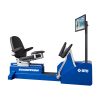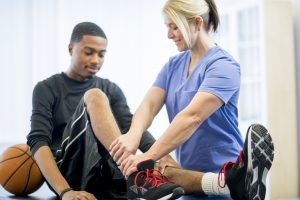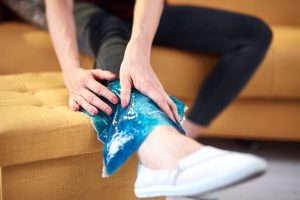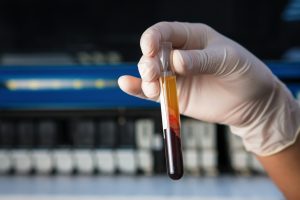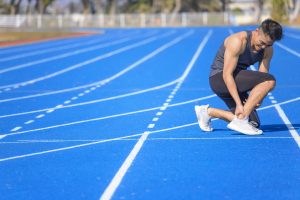
High Ankle Sprains: Getting Back on the Field
Treatment GuidelinesHigh ankle sprains' recovery timeline is notoriously difficult. Let's review basic rehab guidelines to get your athletes back on the field.
With Patrick Mahomes’ recent performance at the big game making headlines across the country, the rehab world is also buzzing about the notoriously tricky high ankle sprain. After experiencing a high ankle sprain in the divisional round, the quarterback’s post-season performance was questionable. Mahomes underwent weeks of intense rehab leading up to the big game and struggled with the injury throughout the evening.
This leads many clinicians, including myself, to start asking questions about this injury. Why are high ankle sprains so debilitating? What should we as clinicians be doing to provide the best care for our athletes?
The High Ankle Sprain Lowdown
The ankle is a dynamic joint and is the foundation of athletic performance. Unfortunately, it’s also a common site of injury during competitive and recreational sports. However, the high ankle sprain is much less common than lateral ankle sprains. This is partially due to the mechanism of injury.
Generally, a high ankle sprain results from an intense rotational force through a planted foot. This occurs most often in contact sports like football, soccer, and hockey as well as downhill skiing.4 With an incidence rate of just ~2.5 per 10,000 exposures for the 2019-2020 NFL season, high ankle sprain isn’t a common occurrence on the field.2 These injuries do, however, result in a lengthy rehab process for NFL players and are correlated with higher age at injury.2
Since the high ankle sprain involves a disruption of the syndesmosis, or ligaments that connect the distal tibia and fibula, this injury can be incapacitating. This results in significant pain, swelling, and difficulty bearing weight. This is because the downward pressure through the ankle mortise stresses the already-injured syndesmosis.
Depending on the degree of the tear and mortise widening, some high ankle sprains will require surgical intervention. Others can be rehabilitated conservatively, although this process is slow and, at times, tedious. Diagnosis of high ankle sprains also remains highly debated. This can result in delayed care and prolonged absence from sport.
Special Testing and Diagnosis
With diagnosis criteria for syndesmosis injuries widely contested among rehab professionals, what is best practice? The main indicator of a high ankle or syndesmosis sprain is pain. Athletes who experience disruption of the syndesmosis will likely report pain with ankle dorsiflexion and external rotation. They may also report tenderness at the distal tibiofibular syndesmosis or ligaments.3
The main tests used to determine the presence of a syndesmosis injury include the Squeeze Test, Cotton Test, External Rotation Test, and Fibular Translation Test. Although there are others, these are the most common research-supported special tests used within the clinic. This battery of tests has been shown to have a clinically significant correlation with arthroscopic findings for syndesmosis injuries.1
Squeeze Test
This test can be performed with the athlete in supine or sidelying. One hand will be positioned on the proximal tibia and the other on the proximal fibula. Compressive force is then applied through both hands to compress the proximal fibula and tibia toward each other. A positive test is indicated by pain at the syndesmosis or distal tibiofibular joint with this proximal pressure.3
Cotton Test
This test begins by stabilizing the ankle with one hand, just superior to the malleoli. The other hand grasps the bottom of the foot with the palm on the medial side and fingers on the lateral foot. Then, a lateral translation force is applied to the foot. A positive test is indicated by 3-5mm of lateral motion or increased lateral instability compared to the contralateral leg. Additionally, the presence of crepitus or a “clunk” can indicate a positive result.6
External Rotation (Kleiger’s) Test
With the athlete seated with their leg hanging in 90-degree knee flexion, stabilize the leg with one hand. Use the opposite hand to bring the ankle into neutral. Then, externally rotate the foot and ankle while keeping the leg stable. A positive test is indicated by pain at the syndesmosis that may travel up the leg.5
Fibular Translation (Drawer) Test
The last test we will discuss, the fibular translation test, is performed with the athlete in sidelying. With one hand stabilizing at the medial malleolus, firmly grasp the fibula at the lateral malleolus with the other. You can then perform anterior and posterior fibular translation mobilizations. A positive test indicates injury to the syndesmosis if there is increased mobility compared to the contralateral leg. Pain with translation is also a positive result.7
Radiography to determine a high ankle sprain can be unreliable. This highlights the importance of special testing by clinicians to detect the presence of a syndesmosis disruption. However, imaging can still be a helpful tool to determine the severity of a high ankle sprain. MRI can detect syndesmosis injury with a normal mortise relationship as well as identify accompanying ligamentous tears.4 CT can also detect possible avulsion fracture that is not evident on a radiographic image.4
Research-supported Treatment for High Ankle Sprains
High ankle sprains can be both physically and mentally difficult for athletes due to the extended recovery time. A recent study found that the average recovery time of NFL athletes with a high ankle sprain was 11 weeks.2 This same study also reports a return to play rate of 90%, which is an encouraging statistic for these athletes. However, this requires time, consistency, and appropriate rehabilitation.
Despite the high ankle sprain’s notoriously difficult rehabilitation timeline, little research exists to guide therapy intervention. Therefore, current guidelines are based largely on clinician expertise. To help get your athletes back on the field, let’s review some basic guidelines for syndesmosis rehab.
The Acute Phase
The acute phase centers on joint protection, minimizing weakness, and managing painful symptoms.8 Weightbearing restrictions will vary depending on the grade of the tear, and the ankle may be immobilized. External rotation, dorsiflexion, and other motions that stress the ankle mortise and syndesmosis should be avoided.
To maintain range of motion, gentle mobility and light resistive exercise may be performed. Depending on weightbearing status, cycling and light stability/proprioceptive exercises may be appropriate.8
Additionally, it will be important to help the athlete maintain cardiovascular health and the strength of surrounding musculature. Throughout the course of rehabilitation, work with your athlete to find methods of cardiovascular training within their weightbearing parameters. Strengthening of lower body musculature can continue via non-weightbearing exercises. Athletes may also participate in core, upper body, and accessory muscle training to maximize their recovery and retain muscle mass.
The Subacute Phase
Once the athlete returns to full weightbearing and more normalized ambulation, they can progress to the subacute rehab phase. This phase will emphasize strengthening, neuromuscular control, and normalized joint mobility.8 Manual therapy and active techniques can be used to maximize joint mobility and range of motion in this phase.
During the subacute phase, we can progress strengthening from isometric to concentric and eccentric exercises. This should include progression from non-weightbearing band resistance to weightbearing drills to incorporate increased proprioception. Additionally, stability training is appropriate in this phase and can be advanced to include perturbations and light plyometrics.
When working with injured athletes, it is important to know when to safely progress weightbearing exercise. With BTE’s rehabilitation equipment, you can eliminate the guesswork. For example, the Eccentron calculates resistance levels based on the athlete’s bodyweight (or max force for high-power training), allowing you to precisely advance session to session.
The Advanced Training Phase
Once an athlete can tolerate light dynamic and plyometric activities, they can progress to the advanced training phase.8 As an athlete prepares to return to sport, their rehabilitation should also be sport-specific. In addition to advanced strengthening, this should include dynamic exercises including cutting and power activities.
Furthermore, it is important to address jumping and landing mechanics as well as sport-specific drills. This may include running reception patterns, dribbling, and other skills that involve rotational or lateral components.8 It is important to incorporate drills that challenge stability and coordination in addition to strengthening for a well-rounded rehab program.
When the athlete can perform sport-specific tasks at game speed, this can justify return to sport.8 However, it is important to note that these should be controlled, quality movements without exacerbation of painful symptoms.
What You Need To Know
High ankle sprains are complex injuries and recovery can be prolonged without timely detection. Special testing can be an excellent tool for clinicians to catch a high ankle sprain. Imaging can also detect disruption of the syndesmosis with a normal mortise relationship or an avulsion fracture.
Athletes will likely experience weightbearing restrictions to allow the syndesmosis to heal. This reduces the stress placed through the ankle mortise and syndesmosis in the weightbearing position. As these restrictions are lifted, exercise can progress from light mobility to more advanced strengthening.
It is important to consider the sport-specific requirements of the athlete and incorporate these into rehabilitation. For example, an athlete returning to soccer needs to be able to perform controlled cutting without exacerbation of painful symptoms. Throughout the rehab process it is also essential to help the athlete maintain their cardiovascular fitness.
A high ankle sprain can be debilitating for NFL athletes and weekend warriors alike. For this reason, intentional rehabilitation is key to promote a safe return to sport. Our goal as clinicians is to progress rehab appropriately, minimize risk of reinjury, and treat the whole athlete. Then we can help our athlete reach their own goal: getting back on the field.
Mariah Kellogg, PT, DPT is a Physical Therapist and health writer. Her career focuses on rehabilitation for neurological and orthopedic populations and she is passionate about patient advocacy. Mariah began her career in Alaska and uses writing as a tool to inspire patients to pursue their health goals as well as to engage with other clinicians about rehab topics.
References
- Beumer A, Swierstra BA, Mulder PG. Clinical diagnosis of syndesmotic ankle instability: evaluation of stress tests behind the curtains. Acta Orthop Scand. 2002 Dec;73(6):667-9. doi: 10.1080/000164702321039642. PMID: 12553515.
- DeFroda SF, Bodendorfer BM, Hartnett DA, Milner JD, Yang DS, Silber ZS, Forsythe B. Defining the contemporary epidemiology and return to play for high ankle sprains in the National Football League. Phys Sportsmed. 2022 Aug;50(4):301-305. doi: 10.1080/00913847.2021.1924046. Epub 2021 May 11. PMID: 33906554.
- Larkins LW, Baker RT, Baker JG. Physical Examination of the Ankle: A Review of the Original Orthopedic Special Test Description and Scientific Validity of Common Tests for Ankle Examination. Arch Rehabil Res Clin Transl. 2020 Jul 8;2(3):100072. doi: 10.1016/j.arrct.2020.100072. PMID: 33543095; PMCID: PMC7853358.
- Molinari A, Stolley M, Amendola A. High ankle sprains (syndesmotic) in athletes: diagnostic challenges and review of the literature. Iowa Orthop J. 2009;29:130-8. PMID: 19742102; PMCID: PMC2723709.
- Kleiger’s Test. [Internet]. Available from: https://www.physio-pedia.com/Kleiger%27s_Test
- Cotton Test/Syndesmosis Injury/Ankle Assessment. [Internet]. Available from: https://www.physiotutors.com/wiki/cotton-test/
- Fibular Translation Test/Syndesmosis Injury. [Internet]. Available from: https://www.physiotutors.com/wiki/fibular-translation-test/
- Williams GN, Allen EJ. Rehabilitation of syndesmotic (high) ankle sprains. Sports Health. 2010 Nov;2(6):460-70. doi: 10.1177/1941738110384573. PMID: 23015976; PMCID: PMC3438867.

